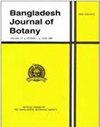水杨酸对湖北贝母重金属胁迫的缓解作用
IF 0.3
4区 生物学
Q4 PLANT SCIENCES
引用次数: 0
摘要
众所周知,水杨酸(SA)可以帮助植物耐受非生物胁迫。然而,SA在植物中的调控功能,如湖北贝母等在重金属胁迫下对外源SA合理施用的反应,尚不清楚。本研究旨在从生理生化指标上评价白藜芦醇对胡氏白檀(F. hupehensis)重金属镉(Cd)危害的缓解作用。结果表明:不同Cd毒性处理下,湖北黄花(F. hupehensis Hsiao)和湖北黄花(k. c. Hsia)球茎发芽率和幼苗生长均有所下降。Cd胁迫下胚根长度和有丝分裂指数也显著降低(P <0.05),特别是在高浓度镉胁迫下。与低浓度处理相比,中浓度处理的球茎发芽率和幼苗生长略有提高。与对照相比,Cd毒性处理显著降低了幼苗色素、蛋白质和糖的含量。cd中毒幼苗总抗氧化剂和丙二醛含量显著升高。综合处理促进了鳞茎和幼苗的生长。在Cd胁迫下,SA处理显著提高了球茎发芽率、胚根长度、有丝分裂指数、色素、蛋白质和糖含量。与Cd毒性处理相比,综合处理降低了脂质过氧化和总抗氧化剂。这项简单的研究极大地拓宽了我们对SA在镉胁迫下的应用和保护的认识。植物学报,52(2):601- 606,2023(6),特刊本文章由计算机程序翻译,如有差异,请以英文原文为准。
Relief effects of salicylic acid against the stress of heavy metal in fritillaria hupehensis hsiao et K.C.Hsia
It is well known that salicylic acid (SA) can help plants tolerate abiotic stresses. Nevertheless, the regulatory functions of SA in plants, such as the response of Fritillaria hupehensis Hsiao et K.C.Hsia to exogenous SA rational application under heavy metal stress, remain unknown. This study aimed to assess the relief effects of SA on the damage of F. hupehensis caused by heavy metal cadmium (Cd), as measured by physiological and biochemical characteristics. The results showed that bulb germination and seedling growth of F. hupehensis Hsiao et k. c. Hsia decreased under different Cd toxicity treatments. The radicle length and mitotic index also significantly decreased under Cd stress (P < 0.05), especially under high concentrations of Cd stress. The bulb germination and seedling growth increased slightly under medium concentration treatment compared to low concentration treatment. Cd toxicity treatment significantly reduced the contents of pigment, protein, and sugar in seedlings compared with the control. The contents of total antioxidants and malondialdehyde in Cd-poisoned seedlings increased significantly. The comprehensive treatment promoted the growth of bulbs and seedlings. As a result of Cd stress, SA application significantly increased the bulb germination rate, radicle length, mitotic index, pigment, protein, and sugar content. Lipid peroxidation and total antioxidants were decreased by comprehensive treatments compared with Cd toxicity treatment. This simple study remarkably broadened our understanding of the application and protection of SA in Cd stress. Bangladesh J. Bot. 52(2): 601-606, 2023 (June) Special
求助全文
通过发布文献求助,成功后即可免费获取论文全文。
去求助
来源期刊

Bangladesh Journal of Botany
生物-植物科学
CiteScore
0.80
自引率
0.00%
发文量
77
审稿时长
9 months
期刊介绍:
Bangladesh in situated on the north of Bay of Bengal. Climatically it is a humid subtropical country. Most of the land is deltaic plain of two great rivers, the Ganges and the Bhrammaputra and it tributaries. The country has rich diversity of plants. Main crops cultivated are Rice, Jute, Wheat, Maize, Sugarcane, Mustard and different kinds of Lentils. There are a good number of Public and Private Universities and Plant Research Establishments.
Bangladesh Journal of Botany is the official organ of the Bangladesh Botanical Society established in 1972. Since 1972 Bangladesh Journal of Botany is being published regularly. Two issues of the Journal are published, one in June and another in December.
Scientific papers (Full paper and short communication) on any field of Plant Sciences from anywhere in the World are considered for publication in Bangladesh Journal of Botany.
 求助内容:
求助内容: 应助结果提醒方式:
应助结果提醒方式:


